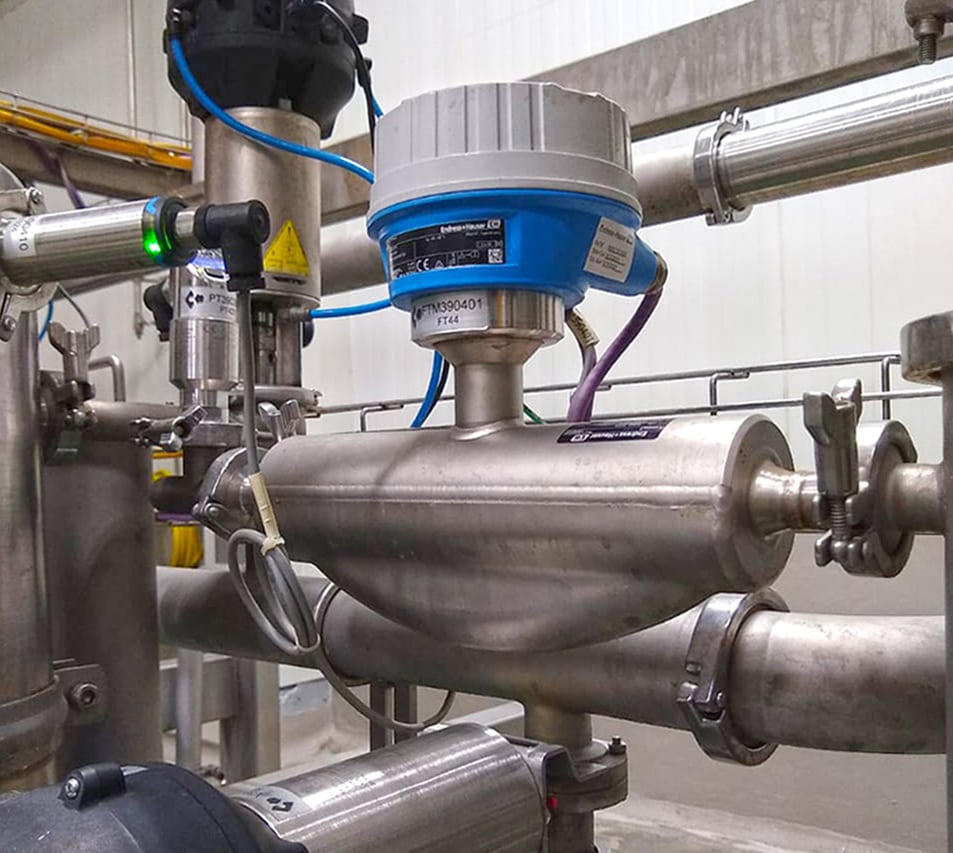FEBRuary 2023

Automation
Plan Now To Save Later
Digital Transformation:
Plan a digital transformation to save energy, improve quality and throughput or iron out supply chain wrinkles—but get started now.
BY Wayne Labs, senior Contributing technical editor
Photo courtesy of Getty Images / NicoElNino
Like most other companies beginning a digital transformation journey, Fonterra—a multinational dairy processor—kept much of its manufacturing data on paper and in several electronic systems. According to Rockwell Automation, which is helping Fonterra digitalize its systems globally, Fonterra data at times could be incomplete or only understood by specific operators familiar with their systems. Data couldn’t be easily contextualized, nor could it be shared with other Fonterra facilities or management. There wasn’t a centralized management process, and version control issues abounded.1
Sound familiar? Some processors are upgrading their existing software systems that have been in place for years with more modern systems capable of taking batch process data to a new level. But they don’t go it alone. Continental Mills sought help from Bachelor Controls Inc. (BCI) to convert its old batch systems supporting single-purpose recipes to data-driven, multipurpose recipes that could provide a significant time savings for recipe development and checkout. And in this case, changeover and implementation took place in a single weekend.
To be able to accomplish such a quick changeover, both companies participated in several project planning meetings, and hundreds of hours of development were consumed with strict adherence to proven project methodologies before conducting a comprehensive checkout and factory acceptance testing (FAT).2
When another BCI client, Wild Turkey Distilling, realized that it was simply out of space in its old facility, the bourbon maker decided to go with a new facility—and take advantage of a digital transformation of its processes. With expert knowledge, BCI and Wild Turkey worked together to capture all aspects of the production process to assure consistency in product flavor and quality. The team also worked together to achieve greater operational efficiency and flexibility.3

An Endress+Hauser smart Coriolis flow meter (middle) and iTHERM TrustSens temperature probe (left) digitally transmit primary and secondary process variables—plus instrument diagnostic data—to a central host system. These instruments ease digital transformation with support for many protocols, including HART over 4-to-20 mA, WirelessHART, Ethernet-APL, or IO-Link. Photo courtesy Endress+Hauser
Planning for Digital Transformation
As we’ve seen, planning for a digital transformation journey takes a lot of work if you want successful results now and down the road. No two food processors will be at the same place on their journey. Here are some questions you're probably asking—and I posed them to automation suppliers and engineering houses. Who all should be participating in the planning? What departments? Where should the discussion start? Who should lead it? Should someone external to the staff lead it, e.g., supplier, system integrator, automation consultant?
“It really depends on what outcome is desired,” says Ola Wesstrom, senior industry manager, food & beverage, Endress+Hauser USA. For operational efficiency, where process diagnostics are derived from instrumentation, operations supervisory staff should drive the initiative to make sure actionable information is identified and collected. Maintenance management should take ownership when the goal is increasing maintenance efficiency. Additionally, controls (OT) and IT personnel must be engaged to execute changes and integrations into new or existing environments.
“For digital transformation to be successful, key stakeholders should all be engaged throughout the journey,” says Alan Stanfill, director, digital transformation, Gray Solutions. “Departments or key individuals including IT, quality, operations, management, engineering and others should all be a part of the process. Communications teams, alongside HR, should communicate throughout the organization about the program and the benefits to the company and individuals. All these groups may not be the enablers of a solution and empowered up front in design and planning. If not, they can unintentionally be a roadblock.”
Digital transformation requires IT/OT collaboration, and the greatest success comes when both departments are involved early, says Mariana Sandin, industry principal at Seeq. Organizations are increasingly looking beyond single-site optimization opportunities, turning attention toward centralized operations for digitalization across all manufacturing sites and teams. These initiatives help identify supply chain and operation improvement opportunities at the enterprise level. A digitalization team frequently consists of a neutral third party working with the company’s IT department, who owns the digital infrastructure, and OT group, who owns the business case, to build and lead roadmaps for the digital transformation journey.
In this quest, sustainability and energy efficiency should not be left out of the discussions, according to Matt Zabel, solutions architect, Faith Technologies, Inc. (FTI), a Control System Integrators Association (CSIA) member. “With the clients I have dealt with, it has been important to ensure operations leadership, engineering and any company sustainability leaders are involved in the planning stages to support the transformation.” It is also wise—if there is not a specialist in energy management in the organization—to consult outside help in this planning process, as well as potential suppliers or design-build partners. The goal is to get the most cost-effective solution, while ensuring that today’s needs are met as well as being prepared for potential future needs. Execution will require engineering and maintenance personnel time to make the change happen or to oversee an outside firm that provides a turnkey system, adds Zabel.

Digital transformation is not possible without access to data, and operational data especially is foundational for every journey. Photo courtesy of Seeq
Top-Down, Bottoms-Up—or Somewhere else?
This discussion—top down or bottom up—is not new as it seems as though it’s been a discussion point since computers entered the “personal” stage in force back in the 1990s. Today, processors have many pieces of automation; some of it may have come with equipment they purchased, some of it may be “legacy,” and aging out—and some automation, e.g., ERP, may still exist on large computing systems or the cloud. In many cases, automation can be hit or miss with the result being unconnected islands of automation.
The foundation of a digital transformation project should be a well-formulated strategy, says Gray’s Stanfill. Important components of a digital transformation strategy include:
• Communications and cultural change about digital transformation and how it benefits team members
• Optimization of processes—with digital transformation, manufacturers often find the opportunity to simplify their internal processes and interconnected processes
• Technology strategy—including cloud, analytics and artificial intelligence platforms
With a strategy defined, and perhaps some core infrastructure implemented, projects can be selected, prioritized and launched based on impact on the business, cost and level of effort, says Stanfill.
“Both top-down and bottoms-up approaches can be successful, but generally, the road is smoother when the top of the organization is bought in and engaged from the start,” says Sandin. “There can be stops and starts with a bottoms-up approach as you encounter new red tape with expanded usage.”
But, does it make sense to choose a certain area to develop a “proof of concept”?
“It is generally easier to start on a smaller scale with a proof of concept, helping ensure the solution is a good fit for the organization,” says Wesstrom. “People, legacy systems in place and skillsets vary from site to site, so starting with a specific area or unit operation makes it easier to define what is best when broadening the scope.”
“Proof of concepts are a great way to get started quickly, but teams often lose momentum when transitioning from a successful proof of concept to a larger rollout,” says Sandin. “Instead, it is preferable, where possible, to begin a longer commitment with planned evaluation criteria to review along the way. This would include defining a few key use cases that are expected to provide a value justification and ROI. In food and beverage, increasing production, while maintaining product quality, is a great use case. In some applications, this can be done through an OEE analysis, and other times, a predictive maintenance analysis for minimizing unplanned downtime may be more effective.”
When evaluating a digital transformation strategy, it is critical to quantify value in terms of ROI, adds Sandin.
“Usually, an effort like energy management has to come from senior leadership in the company, as this and other digital data collection does not always lead to increased product output,” says Zabel. “Operations teams are usually laser-focused on increasing uptime and output. Other tasks will be a priority C to operations if there is not a senior leader explaining the importance behind the change. Starting small is always a good idea to vet concepts. If, using a software and hardware package, we can show an energy savings of 5% in a process or key part of a facility, getting support for the other areas becomes less difficult. Also, any communication or software standards can be ironed out prior to ‘roll out’ to an entire facility. However, with energy management in particular, because electrical or gas outages are usually required to install metering hardware, it may be most cost effective to cover the entire facility during a major planned outage and plan on iterative software updates as needed.”
Final Thoughts on Digital Transformation Projects
Establishing a steady baseline for collaboration among all stakeholders early on and maintaining consistent communication is paramount to project team purpose and work plan alignment. —Ola Wesstrom
The real value in a digital transformation journey is in the business impact and not the technology. It’s more about the decision enabled than the data itself. —Alan Stanfill
Digital transformation is an ongoing process…. Digital transformation is not possible without access to data, and operational data especially is foundational for every journey. —Mariana Sandin
A digital transformation is a journey. Take the time to evaluate the short-, medium- and long-term needs of your organization. —Tyler Newcombe
Key Tech Considerations
Getting the right people involved in planning is crucial. Engage multiple teams early in the journey, says Dan Engelhard, VP, business development, Gray Solutions. Document the requirements from engineering, plant management, quality, IT/OT, digital transformation/MES and corporate perspectives. Outside assistance for open exchange of current and future state information is also recommended. These parties should all agree and sign off on the plan of action. From there, source the technology to match the requirements.
Determine who needs what information, and what activities will it inform, says Wesstrom. Data for data’s sake is useless. Project teams must clearly define upfront the information available, how it will be used (what improvements will it drive) and by whom. From there, the integration and data structure—including network infrastructure, communications protocols and network devices—can be specified.
More specifically, Zabel lists the need for defining:
• Devices that will be installed, where and for what purpose
• Device IP communication configuration
• Network logical segregation and an understanding of TCP/IP ports that need to be available
• Plans for how data will be shared among MES and control systems
• A functional specification that describes how new systems will work, what they will provide, how they will communicate with each other and what the user interface will look like
Besides fine tuning the network and security infrastructure to the facility and the processor, adherence to industry standards is important, says Matt Pike, manager OT infrastructure, Gray Solutions. “We utilize the latest industry standards as seen in Cisco CPwE, IEC 62443, Factory 4.0, NIST 800 and many others to determine our key design decisions. We strategically approach the project with proven, conceptual designs while conforming the solution overall to our customers’ requirements and standards.”
Data storage and security standards are also important considerations, says Sandin. “In most cases, data is stored in multiple locations, including plant historians, MES systems, LIMs and more, requiring an advanced analytics solution to centralize information from the disparate sources. Teams should examine the security measures of their SaaS (Software as a Service) solutions and ensure the necessary protections are in place, such as SOC 2 (System and Organization Controls 2) compliance.”
SOC 2 is a type of audit report that attests to the trustworthiness of services provided by a service organization. It is commonly used to assess the risks associated with outsourced software solutions that store customer data online.

Siemens Digital Industries provides industrial software, automation and IIoT hardware and services via its Xcelerator Portfolio to facilitate digital transformations and enable manufacturers to realize a comprehensive digital twin. Photo courtesy of Siemens Digital Industries
Measuring Project Success
The biggest key to evaluating success of a project is to define the target result and criteria for success at the outset, says Gray’s Stanfill. Specifically, what is used to evaluate the project is not as critical as ensuring alignment of the criteria with stakeholder expectations and business needs.
Each step of the digitalization journey should have associated key performance indicators (KPIs) that indicate the step’s success, says Siemens’ Newcombe. These KPIs are agreed upon prior to project kickoff, assessed throughout implementation and reviewed after go-live to confirm continued success and to identify any additional adjustments or training required. This procedure helps evaluate each project within its given discipline and for its impact on the broader organization.
It is important to capture and document use cases and their value impact, adds Seeq’s Sandin. References to the impact an improvement made in terms of man-hours saved, percentages of improvement, additional OEE points, dollar amount added or saved, or the number of incidents avoided are great indicators of value for the organization. Other evaluation criteria might be ease of use, user adoption, or employee time saved for existing manual tasks.
Success for an energy management project is either giving the manufacturer information to optimize its energy spend or find issues that would have caused outages or equipment failures before they happened, says FTI’s Zabel. Success for automated data collection helps the processor focus in on downtime reasons, compare machines against each other, and ultimately optimize their production processes. FE
References:
[1] “Case Study—Digital Transformation: Fonterra Co-operative Group Improves Processes,” Rockwell Automation website; accessed 12-29-2022
[2] “Case Study: Mix Plant Control System Conversion and Upgrades,” Bachelor Controls Website; accessed 12-29-2022
[3] “Case Study: Wild Turkey Bourbon New Distillation System, Capacity Expansion—New, Purpose-Built, Distillation Facility,” Bachelor Controls Website; accessed 12-29-2022
february 2023


